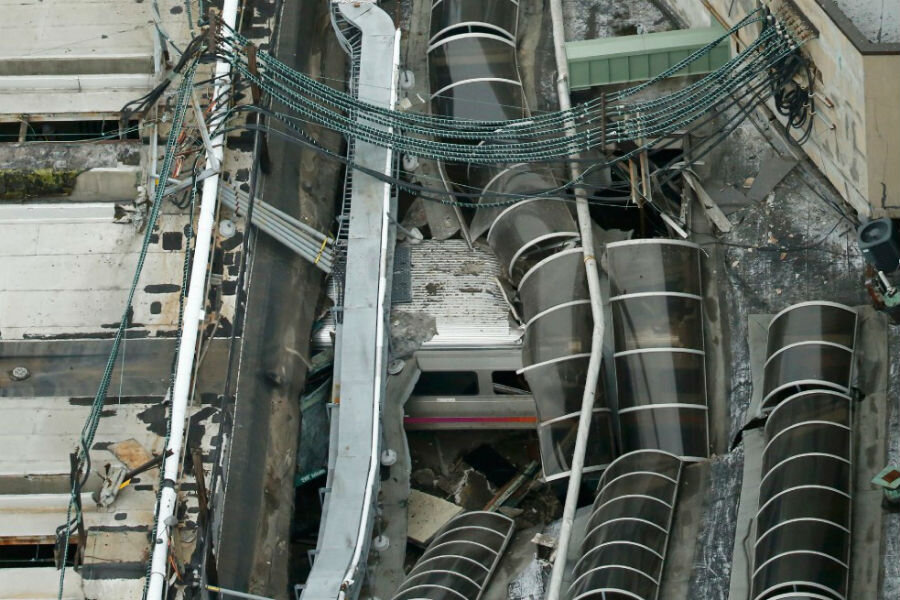Hoboken crash: Is the nation's rail system in need of repair?
Loading...
The New Jersey Transit train that crashed into a station Thursday morning during rush hour is the latest tragedy for a transportation agency already plagued with problems – and it’s one that some say could have been avoided.
The crash Thursday morning killed one person and injured at least 75, New Jersey officials say. Passengers recounted that the train was going on a speed faster than usual before the crash, and it didn’t slow down when it approached the station at Hoboken, according to CNN.
“What we know is that the train came in at a high rate of speed,” New Jersey Gov. Chris Christie told CBS2 in an interview. “At this time, folks should know that we have no information that leads us to believe that this is anything but a tragic accident.”
While the cause of the crash is under investigation, it occurred at a time when the cash-strapped state transit agency risked shut-downs and delays on new projects, as the state's Transportation Trust Fund was scheduled to run out of money. Last year, the state agency obtained an extension until 2018 to install the Positive Train Control (PTC) system, a program mandated by the US Congress to prevent high-speed derailments. The original installation deadline was 2015.
Given the state's transit funding troubles, there have been concerns raised about the ability of the agency to ensure safety and provide consistent service to passengers. "Maybe nothing catastrophic has happened, but maintenance cannot be deferred," Martin Robins, of the Voorhees Transportation Center at Rutgers University, said earlier this week, according to NJ.com. "It's absolutely wrong, when you're operating something as potentially dangerous as a rail system. So this lack of transparency is alarming."
Matthew Walters, a New Jersey resident who works in New York, says even before Thursday's crash there were long delays.
“I’ve been delayed for an hour and a half. My wife once experienced a three-hour delay stuck on a train,” Mr. Walters tells The Christian Science Monitor in a phone interview. Walters co-founded a Facebook support group for frustrated riders like himself. “It’s going to take politicians at the local, state and federal level having the courage to put money into the transportation infrastructure, they’ve been talking about it for years.… Had the PTC been installed, this morning wouldn’t have happened.”
But New Jersey is not alone in facing funding shortfalls for rail transit. Washington, D.C. has seen multiple Metro shutdowns and other incidents in the past year blamed on the funding shortage. Several Amtrak derailments since 2012 have also pushed the issue into the national spotlight.
The Hoboken crash, say transportation experts, tragically underscores the need for maintaining and upgrading public transit systems amidst an aging infrastructure and growing urban populations.
“The usable life of a lot of infrastructure in the United States is coming to an end,” Edward Alden, senior fellow at the Council of Foreign Relations, tells the Monitor in a phone interview. Mr. Alden authored a study on transportation infrastructure in January. “There are safety concerns if you don’t refurbish your infrastructure.… You have to expand your capacity along with the population.”
Alden’s report puts the United States behind its peer industrial nations in terms of investing in transportation infrastructure. Public transit systems and highway construction are typically funded by gas taxes, but the report states that the gas tax revenues have not been increasing with infrastructure costs because Congress has failed to raise the tax levels since 1993.
“The United States dramatically underspends on infrastructure,” Alden says. “The United States is falling behind almost all of the major economies of the world in terms of upgrading its infrastructure, and the main reason for that is the government doesn’t want to spend money on that. It’s a tremendous kind of short-sightedness because infrastructure projects have very long payback periods.”
But the cost of maintaining the railways, expanding services, and adding safety measures can be high. The Positive Train Control system, for example, is an expensive technology that is complex to install. It's a GPS-based technology that can prevent train collisions, over-speed derailments, and even unauthorized incursion into work areas. But only 29 percent of commuter railroads met the 2015 federal deadline.
For New Jersey, the Transportation Trust Fund designed to support road and rail repairs was scheduled to run out this summer, triggering a political debate over how to find new revenue sources. That resulted in Gov. Christie imposing a months-long freeze on statewide road construction this year, NJ.com reported.
New Jersey elected officials didn't want to raise gasoline taxes. To fill the budget shortfall, public transit fares were hiked and services were cut. N.J. Transit, as reported by Bloomberg in January, faced frequent breakdowns and had the worst performance last year.
“You don’t need to be a transportation engineer to figure out that if you don’t maintain your equipment, it breaks down and ages a lot more quickly,” Senate Majority Leader Loretta Weinberg, a Democrat from Teaneck, told Bloomberg. “You don’t need to be an economist to figure out the toll that takes on growth.”
Discussions this month resulted in a consensus to boost gasoline taxes to 12.5 percent, as NJ.com reports, bringing the state from the second-lowest gas taxes in the nation to the seventh-highest.
"The idea of a tax hike on the gas tax is obviously something that nobody wants.… We have big roadways and bridges to deal with in this state and a big mass transit system," Gov. Christie said. "We gotta pay for that."
A ballot measure in November will also ask voters to decide if future gas taxes will be fully dedicated to transportation projects.






